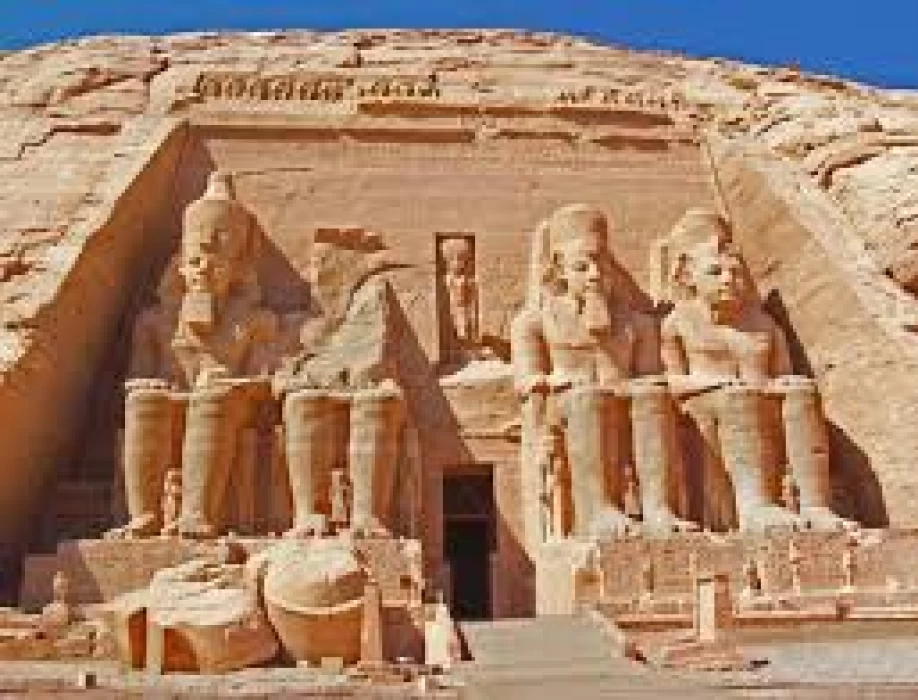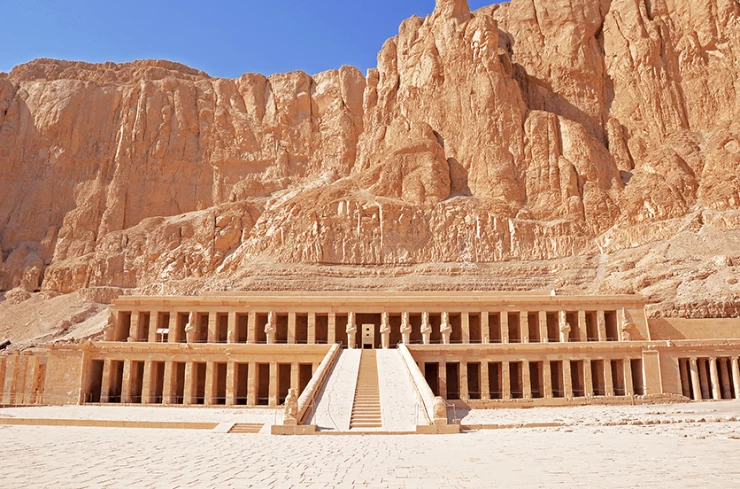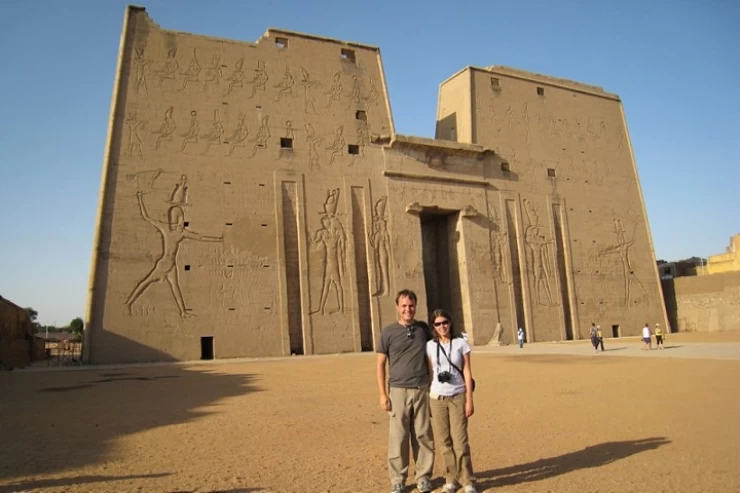
The New Kingdom of Egypt History
The New Kingdom of Ancient Egypt
The capital was established in Thebes, in the south, and the restoration of the unity of Upper and Lower Egypt, lost during part of the Second Intermediate Period, was carried out. From the beginning, there was a great activity to restructure the country, which produced great prosperity, reflected in the construction of numerous monuments. Explore our Egypt tours to the city of Luxor to discover the great Egyptian history in the new kingdom and the most important works of Egyptian kings.
This period is characterized by the great importance of women and their role in succession problems. For the first time, a woman is named Pharaoh with all the male titles: Hatshepsut, and also another queen, Nefertari, is represented in family scenes, on an equal footing, as is Queen Tiyi, with her husband Amenhotep III and mother of Amenhotep IV, who later became Akhenaten. Heading to our Egypt luxury tours to Luxor to discover the Hatshepsut temple, and it has great history and works.
Akhenaten's Rule and Religious Revolution:
One of the most enmeshed in controversy and uniqueness in the history of the New Kingdom was in the reign of Amenhotep IV, who altered his name to Akhenaten (c. 1353–1336 BCE). Akhenaten was mainly remembered for the radical religious changes intended to abolish the Egyptian traditional polytheistic belief in favor of one god worship, the Aten, the sun disk. It may be one of the earliest forms of monotheism in history.
Akhetaten (modern-day Amarna) was a new city where Akhenaten transferred the capital from Thebes and promoted the worship of the Aten before all other gods, thus alienating the powerful Amun priesthood. The reforms hardly endured; however, the reign of Akhenaten saw major artistic and cultural changes, including a peculiar style of image-making that rendered the royal family in a more naturalistic manner.
Soon after Akhenaten's death, Egypt reverted to its ancient polytheism, and the city of Akhetaten stood deserted. The next pharaoh, Tutankhamun (1332–1323 BCE), reinstated the old order, and the brief reign of the young king is chiefly celebrated for the discovery of the tomb largely intact in 1922 by archaeologist Howard Carter.
The international situation at the moment consisted of the Egyptian territory over the Canaanite cities. In Assyria, the last kings of the Old Kingdom and those of the Middle Kingdom reigned, and the house domination occurred in Babylon, also agreeing with the fall of the Mycenaean kingdoms in Greece and the Exodus from Israel only existing in Egyptian sources.
The study of the eighteenth dynasty is usually divided into three stages that comprise first the first kings: From the time of King Ahmose, who defeated the Hyksos, Thutmose, and the story of the most powerful women in history, Hatshepsut, and the liberation of Amenophis IV with his famous rebellion and transformation of the capital to Amarna city with the new religion forced by him to worship Aton instead of the traditional sun cult of Amun Ra. Not forgetting the restoration of the old cult under his son, King Tutankhamun.
The 19th dynasty begins with Ramses I (1293-1291), a sovereign of Tanis (Delta). The reign of Ramses I was peaceful. The work of his predecessor, Horemheb, paid off in his fight against the Hittites, and his good administration was noticed in the following years, managing to reorganize the kingdom. Since he had no male heir, he passed the power on to another soldier who was a warrior ruler. But the most powerful king during this dynasty is Ramses II.
The Hittites were defeated by Ramses II, who made a great contribution along with his reign in architecture by erecting Abu Simbel temples, which are two massive rock temples at Abu Simbel, a village in Nubia, Upper Egypt, near the borders with Sudan.
Actually, there's a lot to talk about during the New Kingdom epoch, but you can browse our list of dividing the history of Egypt into kingdoms interrupted with intermediate periods and classified into 30 dynasties.
Kings of the New Kingdom: 1550–1070 B.C.
The 18th dynasty: 1550–1295 B.C.
Ahmose 1550–1525 B.C. Amenhotep 1525–1504 B.C. Thutmose I 1504–1492 B.C. Thutmose II 1492–1479 B.C. Thutmose III 1479–1425 B.C. Hatshepsut (as regent) 1479–1473 B.C. Hatshepsut & 1473–1458 B.C. Amenhotep II 1427–1400 B.C. Thutmose IV 1400–1390 B.C. Amenhotep III 1390–1352 B.C. Amenhotep IV 1353–1349 B.C. Akhenaten 1349–1336 B.C. Neferneferuaton 1338–1336 B.C. Smenkhkare 1336 B.C. Tutankhamen 1336–1327 B.C. Ay 1327–1323 B.C. Horemheb 1323–129.
The 19th dynasty: 1295–1186 B.C.
Ramesses I1295–1294 B.C.Seti I1294–1279 B.C.Ramesses II1279–1213 B.C.Merneptah1213–1203 B.C.Amenmesse1203–1200 B.C.Seti II 1200–1194 B.C., Siptah 1194–1188 B.C., Tawosret 1188–1186 B.C.
The 20th dynasty: 1186–1070 B.C.
Sethnakht 1186–1184 B.C. Ramesses III 1184–1153 B.C. Ramesses IV 1153–1147 B.C. Ramesses V 1147–1143 B.C. Ramesses VI 1143–1136 B.C. Ramesses VII 1136–1129 B.C. Ramesses VIII 1129–1126 B.C. Ramesses IX 1126–1108 B.C. Ramesses X 1108–1099 B.C. Ramesses XI 1099–1070 B.C.
Take advantage of this offer and discover the wonders of the blessed land of Egypt, from historical times to the present day.
Latest Articles
Admin
Seabourn Sojourn Cruise Stops in Safaga Port
The Seabourn Sojourn, the flagship vessel of Seabourn Cruise Line's ultra-luxury fleet, was built in 2008 at the T. Mariotti shipyard in Genoa, Italy. Measuring 198 metres, it can accommodate up to 450 guests in its 225 spacious all-suite staterooms.
Admin
Norwegian Sky Cruise Stops in Safaga Port
Norwegian Cruise Line operates a cruise ship called the Norwegian Sky. It was constructed in 1999 and can accommodate 2,004 passengers in addition to 878 crew members. The ship has several dining establishments, lounges and bars, a spa and fitness center, swimming pools, and a number of entertainment areas.
Admin
Explora II Cruise Stops in Safaga Port
Explora II, the second vessel in the Explora Journeys fleet, sets sail in 2024 to redefine luxury cruising. With 461 ocean-front suites, 9 culinary experiences, and 4 pools, this haven of sophistication and sustainability promises an unforgettable "Ocean State of Mind" journey to inspiring destinations.
Admin
Mein Schiff 6 Cruise Stops in Safaga Port
The Mein Schiff 6 is the latest cruise ship in the renowned TUI Cruises fleet, offering passengers a luxurious and sophisticated cruise experience. At 315 metres long, this floating resort features a range of dining options, entertainment, and recreational facilities, including a spa, fitness centre, and sports amenities.
Admin
Mein Schiff 4 Cruise Stops in Safaga Port
When the Mein Schiff 4 cruise ship docks in Safaga, Egypt, passengers are granted access to a realm of ancient wonders. Aboard this state-of-the-art vessel, guests can embark on meticulously curated shore excursions that showcase the region's most iconic landmarks, including the Giza Pyramids, the enigmatic Sphinx, and the remarkable tombs and temples of the Valley of the Kings in Luxor.
Admin
MS Europa Cruise Stops in Safaga Port
The Silver Moon, Silversea's latest flagship, is a luxury cruise ship that offers an exceptional travel experience for Venezuelans exploring Egypt. With a capacity of 596 guests and an impressive 40,700 gross tonnes, the Silver Moon maintains the small-ship intimacy and spacious all-suite accommodations that are the hallmarks of the Silversea brand.

















